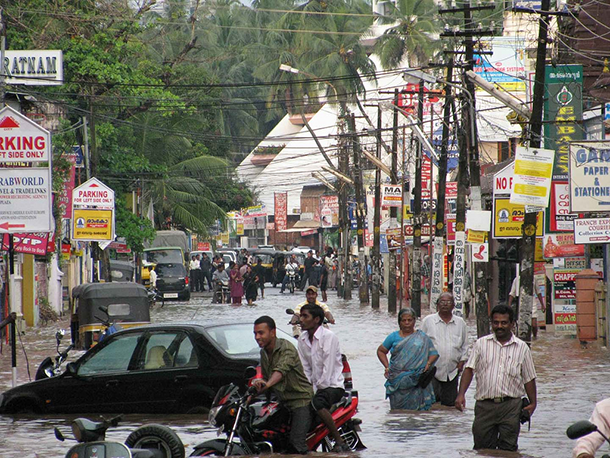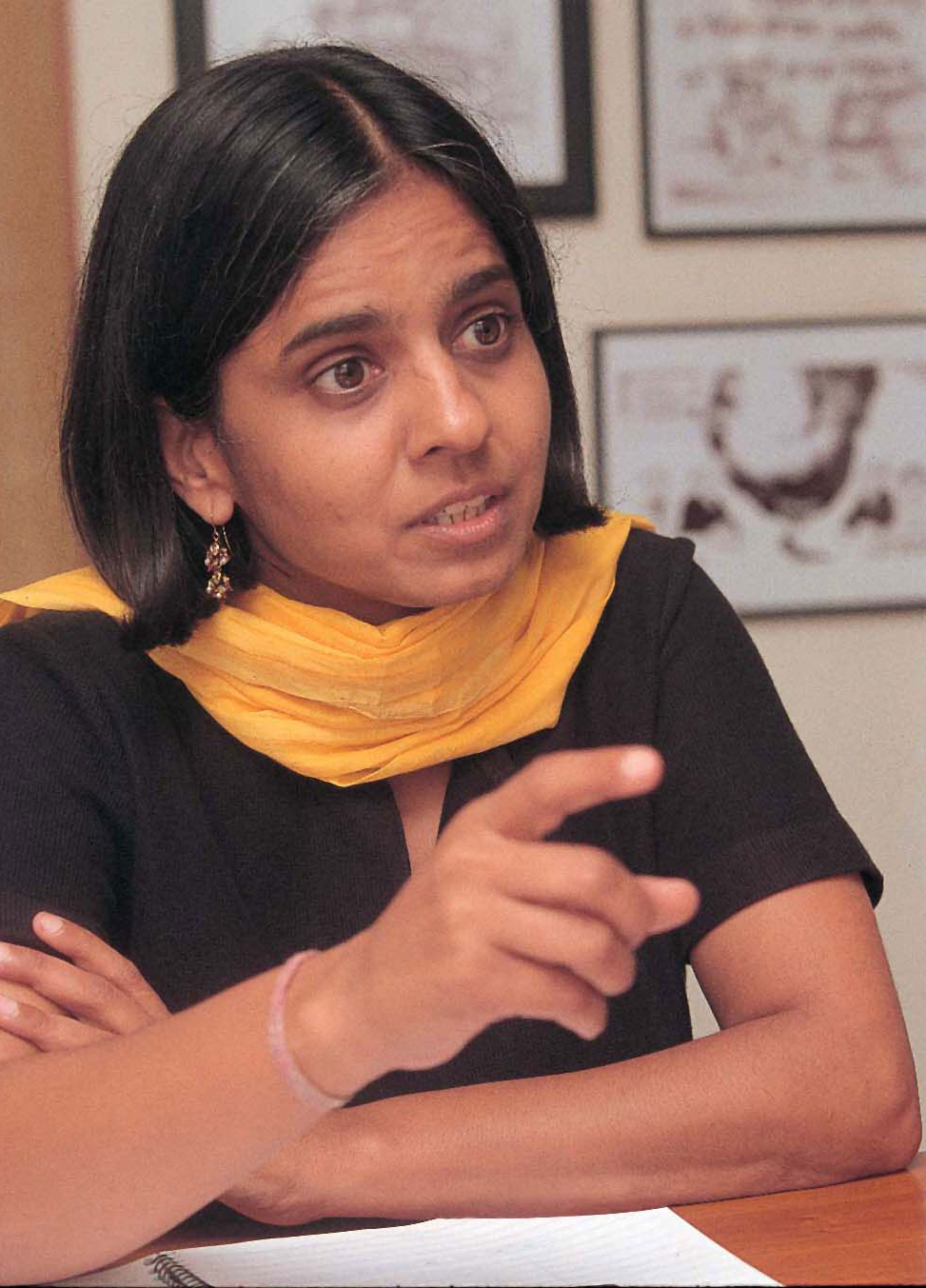India Says UN Climate Summit Fails Poor Countries
Air Date: Week of December 19, 2014

Thampanoor the transport hub of Trivandrum, capital city of Kerala in India. The monsoon and lack of planned drainage systems leads to flash floods on roads. The sight is quite common during the monsoon, in the inner city areas close to the rail & bus terminals. (Photo: indiawaterportal.org; Flickr CC BY-NC-SA 2.0)
Earlier this month, for the first time, all 190 nations meeting in Lima Peru pledged to present actionable plans to cut CO2 emissions by early next year. But many feel that the landmark accord wasn’t strong enough. Host Steve Curwood discusses India’s need for cash for clean development, its role in UN climate negotiations, and how to share global warming’s burden fairly with Sunita Narain, Director General of India’s Centre for Science and the Environment.
Transcript
CURWOOD: From the Jennifer and Ted Stanley Studios in Boston and PRI, this is Living on Earth. I’m Steve Curwood. The climate summit, in Lima, Peru earlier this month, produced a major breakthrough. For the first time, all nations, developed and developing, agreed to lay out their plans to cut global warming gas emissions ahead of next year’s crucial summit in Paris. China, the world’s biggest carbon polluter, was the first major developing country to say when it will cut emissions. China’s per capita carbon emissions are 8 tons per year. The second biggest polluter, the US, produces 19 tons per person per year, but the number three emitter, India, produces less than two tons of carbon per capita. India desperately needs more power to meet its development needs, but says without help it can only afford to use more cheap, dirty coal. Joining us on the line from New Delhi is Sunita Narain, Director General of the Center for Science and the Environment in India. Welcome back to Living on Earth, Sunita.
CURWOOD: So first, in terms of the overall impact of the Lima deal, how good was it the world and the threat of disruptive climate change do you think?
NARAIN: Steve, I have to say we are very disappointed. I cannot say otherwise. The fact is, Lima needed to take tough decisions. We're at a very difficult space as far as climate change is concerned. A country like India is very vulnerable to climate change. I keep saying the monsoon in India is our true finance minister. The poor in India are being continuously hit by more and more extreme weather events. We know we need the world to take stuff action on climate change and yet at Lima many decisions that are important for the developing world was sidelined, and the tough decisions that we need for the world to review how serious it is going to be about cutting emissions at the base and the scale that is needed even that review was put aside. So what we are anticipating is a weak Paris deal.

The developing country of India is the world’s third largest CO2 polluter and its growing economy is still very much dependent upon coal energy. (Photo: Ben Beiske; Flickr CC BY-NC-SA 2.0)
CURWOOD: Let's talk about in your view what was needed there, first, in terms of making a meaningful impact on the threat of climate disruption. What needed to be decided at Lima that wasn't your view decided?
NARAIN: Well, first, I think we need to make it very clear that countries need to take drastic action to reduce their emissions and even as Lima has agreed that these would be done through internationally determined actions, the fact is what we need is for countries to agree they will review those actions and make sure that the world is below 2 degrees, and that those actions also are fair even as they are ambitious, and I give you an example. The fact is that the US and China have just signed what many in the US are saying is a historic and ambitious deal to cut emissions, but when we in India have taken a look at it, we are finding that what this agreement does is to actually make sure that both countries, both big polluters, get more right to pollute, they equalize their emissions at 12 tons per capita in 2030 and more than that it means the world will not be able to keep temperatures below 2 degrees, so what Lima needed was a strong review process which would hold countries accountable, both in terms of ambition and if it is fair or not. The China/US makes sure that the two big polluters take up the biggest share of the atmosphere and leave nothing, no space, for the rest of the world to grow. That is what we need Paris to take tough actions on.
CURWOOD: So let's talk about India specifically. Under the Lima accord, for the first time, India's going to be asked to say what it will do to reduce emissions and as of 2012, your nation was the world's third largest emitter of greenhouse gases. How fair and effective is this Lima deal for India?
NARAIN: Well, I think it's very important for all countries to be part of a global agreement, so in that senses I think India needs to also put its own commitments on the table. There is no doubt that we all need to do something to combat runaway climate change, but the fact of the matter is, and I'll just give you some barebone figures just so that you understand the differences that exist. India's emissions today are 1.8 tons per person per year. China is eight tons. The US is 19 tons. In 2030, the US will be 12 tons. China will be 12 tons. India, even if it does business as usual will be four tons per person per year. So whereas India has to take steps to cut emissions, it has to do that in its own best interests because we need to become more energy efficient, we need energy security, we need to cut air pollution in our cities, but whatever India does is not going to be enough unless the big polluters in term of volume actually reduce and make space for the rest to grow.
CURWOOD: As the negotiations move forward, India's government is saying that it needs to build more coal-fired power plants. How much sense does that make in terms of climate stability?

Coffee production around the world has been adversely impacted by climate change, and developing countries such as India are less equipped than first-world countries to deal with the effects this has on food production. (Photo: Thangaraj Kumaravel; Flickr CC BY 2.0)
NARAIN: Well, it is a fact that India has a massive challenge to reach energy to very poor people. We have almost 30 million people who are still without energy in own country. 700 million people cook using dirty biomass fuel. And it cannot be acceptable for any government that you would allow your people to have no electricity not even a bulb to read under. No education as a result of it. That energy poverty is not acceptable. Now, given that situation, what choice does a country like India have? We can do coal which is much cheaper, or we can do solar, and many grids using solar, but that is still much more expensive. Now, if the word wants a country like India to leapfrog and go towards a future in which we can actually not go through the fossil fuel route, which no country in the world has done until now, and if that is the option then we will require money, we will require technology. Today, all governments in the world build grids because they are at scale, they are much cheaper, they build grids using fossil fuels, even the United States today is coal dependent, and if at all it is moving out of coal, it is moving to another fossil fuel, which is shale. It is not moving out of fossil fuel to renewable energy. The poor in the world have to provide us the options; then they have to be supported so that we can actually make the transition towards a low-carbon future.
CURWOOD: So how much would that leapfrogging cost and where would the funds come from?
NARAIN: Well, we have done some calculations for the government of India because we feel we do believe that the government of India needs to begin doing this. We are getting the government to think about a mini-grid policy for leapfrogging. Clearly it would mean first building some stations, looking at the cost, seeing what's the differential between a grid-based station and a mini-grid station. It's normally three to four times higher to supply energy using mini-grid simply because you have to literally duplicate or replicate the system for energy supply at a local level. But those plants could be grid interactive you may find a way to also reduce the costs, so I think the question is for countries like India who want to be able to leapfrog to have those options. We are certainly pushing our apartment but it would also be much easier if the rest of the world was put forward an agenda that says that climate change concerns us all, we will all reduce, the rich will reduce more so they will provide space for the poor to grow, and they will provide technology and finance so that all of us can build that new future. We are still not getting that in any climate negotiations and this time in Lima the distrust between the rich and the poor a new low where everything of concern to the developing countries, whether is it adaptation, whether it is finance, whether it is the issue loss and damage was seen to be negated by the more powerful countries, which means there is even less room for negotiations.

Sunita Narain is the Director General of The Centre for Science and Environment in India. (Photo: Courtesy of The Centre for Science and Environment)
CURWOOD: In an ideal world, Sunita Narain, how would you design a climate accord, an international climate deal?
NARAIN: I would design a climate deal, which is very similar to what we had in 1992, at the Rio Summit. I would design a deal which would make the world know that there is not that the space for growth is limited, that we all need to live within the planetary boundaries so between the two-degree target it becomes absolutely non-negotiable. We then have a space that we would need to share between nations, and that space would have to be shared on some principle of equity. Now it is very clear that you cannot ask the US to go down from 19 to two tons and therefore meet India's target today, but you can certainly ask the US and other large countries and say if you cannot reduce your emissions, then you need to walk the talk in terms of providing the money and technology so that the poor countries can grow differently. You need countries to build a climate agreement, which is built on trust between nations. You cannot therefore have a Paris deal, which is not based on principles of equity and justice.
CURWOOD: Sunita Narain is the Director General of the Center for Science and the Environment in New Delhi, India.
NARAIN: Thank you, Steve; I really enjoyed the show very much.
Links
The United Nations’ Lima Climate Change Recap
More about Sunita Narain and her work with The Centre for Science and Environment
Living on Earth wants to hear from you!
Living on Earth
62 Calef Highway, Suite 212
Lee, NH 03861
Telephone: 617-287-4121
E-mail: comments@loe.org
Newsletter [Click here]
Donate to Living on Earth!
Living on Earth is an independent media program and relies entirely on contributions from listeners and institutions supporting public service. Please donate now to preserve an independent environmental voice.
NewsletterLiving on Earth offers a weekly delivery of the show's rundown to your mailbox. Sign up for our newsletter today!
 Sailors For The Sea: Be the change you want to sea.
Sailors For The Sea: Be the change you want to sea.
 The Grantham Foundation for the Protection of the Environment: Committed to protecting and improving the health of the global environment.
The Grantham Foundation for the Protection of the Environment: Committed to protecting and improving the health of the global environment.
 Contribute to Living on Earth and receive, as our gift to you, an archival print of one of Mark Seth Lender's extraordinary wildlife photographs. Follow the link to see Mark's current collection of photographs.
Contribute to Living on Earth and receive, as our gift to you, an archival print of one of Mark Seth Lender's extraordinary wildlife photographs. Follow the link to see Mark's current collection of photographs.
 Buy a signed copy of Mark Seth Lender's book Smeagull the Seagull & support Living on Earth
Buy a signed copy of Mark Seth Lender's book Smeagull the Seagull & support Living on Earth

